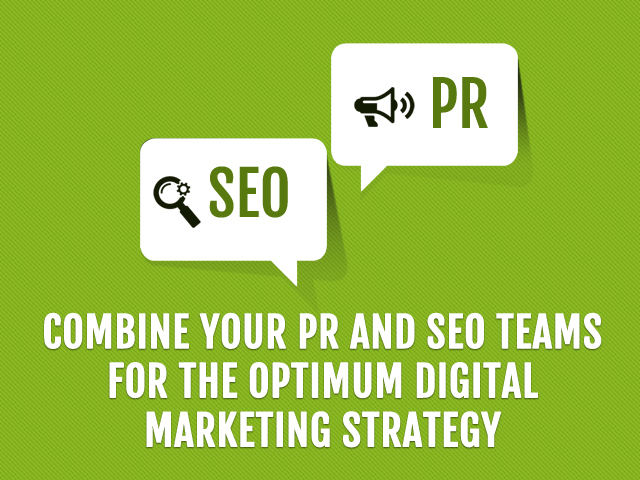
The age of combined PR and SEO
In today’s landscape, we have more than 3 billion internet users all across the globe. With this greater-than-ever online activity, marketers –irrespective of the strategies they are following, are looking for a more comprehensive and holistic approach to meet their overall business objectives. Way back, SEO and Public Relations were considered two separate domains with downright contrasting marketing features. Few years ago, if someone wanted to promote his website, all he had to do was to place a cluster of links in various blog comments and get ample links in return and a high Google rank for his webpage. Fortunately, we have moved on. Google has become 40 times more demanding and penalty centric when it comes to black hat SEO techniques. Adopting short cuts to inflate ranks such as keyword stuffing, duplicate or poor quality content or mindless link building are instantly identified and penalized. And as far as today’s marketing is concerned, the traditional and the revolutionary ways have merged into one comprehensive approach with SEO on one hand and PR on the other, each complementing the other.
But how do these two distinct domains – PR and SEO relate to each other? With time, Google came to emphasize more on quality and relevance over quantity as a metric to evaluate web pages. The essential online optimization processes on search engines like Google, Bing and Yahoo depend on one bottom line – value addition to the end user. High quality engaging content and links to relevant and informative resources related to the subject are considered examples of this category. Incoming links from authoritative relevant networks are a bonus (as difficult as they may be to achieve).
On the other hand, a PR professional (who essentially works to improve the Public Relations of the client) generates awareness, trust and seeks to invite attention of audience by getting others talk about the brand. Both SEO and PR therefore share the same intrinsic objective of getting brand recognition and popularizing their subject to their target audience. In a way, both work by reaching out to suitable publications that offer excellent content to its targeted audience, and publish articles, share information to attract new and potential readers and consumers and thereby get appreciated and endorsed. In both cases, the goal is to create a positive buzz around the Brand and to be made available (through references and advertisements) when searched by potential customers.
Apparently, the only major factor which creates a marked difference between the two is that, while both aspire to market their respective brands, SEO experts expect getting a link from the third party source back to their domain. This helps visitors (and more importantly Google bots) to travel back to the original domain from multiple web locations, thereby adding to its authenticity. On deeper analysis, we can bring out some core differences between PR and SEO. Structuring a website efficiently, establishing Meta and OG tags, using non dynamic URL structure, optimizing crawlable content, improving page speed are few of the on page SEO activities. These have really got nothing to do in PR. Off page PR and SEO can look alike but the key difference lies in their on-page attributes.
Quality content is the common denominator in SEO and PR. Ken Krogue, the notable Forbes contributor admits that Google only prioritizes original and relevant content. Blogging, events, PR stunts and content calendars are the mediators which can rapidly boost sales if both of the objectives of SEO and PR are merged together. Today, most of the PR firms and web designing companies are implementing their skill sets and working as a group to achieve one common goal for one and the same client. SEO belongs to the media & public relations department of a web designing company. From a practical standpoint, PR professionals can train a thing or two to the SEO executives on exceptional pitching. PR executives are adept in handling long-term relationship with their media partners. Contrariwise, SEO experts are accomplished in handling research tools like Google Analytics, AdWords and Google Webmaster Tools to analyze numbers and traffic. Managing content calendar is a common task for both these inter-related arms of marketing.
Content calendar is a shareable reserve for advertising and promotion. It helps to plan the content marketing effectively. According to Cynthia Johnson, who is a content specialist, a content calendar helps
- to chalk out content strategy for major events and important dates relevant to an industry,
- to prepare content timely, and
- to identify the gaps in content and insert more content therein.
This powerful tool of content marketing is a significant contributor to marketing, online or otherwise. Online PR, quite like the traditional PR, influences people via blog, social media, and a cover story in a magazine or a daily. They target every online platform and networks effectively. Web searchers, social media users, bloggers, columnists and writers, websites and directories, lists and organizations are the prime targets for online PR. All of it aside, SEO experts are anxious on receiving a high quality link from this content network to mark it an effective marketing.
Both PR and SEO are dexterous in generating compelling content. SEO has the access to the numbers based on actual traffic, conversion and effective call-to-action hits. How many times a piece of content is liked, shared or bookmarked, along with the social media KPIs are effectively handled by an SEO expert to decide on organic ranking of a website. He can review these numbers and can tell you which way is the marketing headed.
Both PR and SEOs are skilled in the effective administration of social networks and channels. In order to beat Facebook, G+ activity is used as a measuring tool by Google to manipulate organic search ranking for a website. The G+ page of a company is generally managed by the PR professionals.
So as it transpires, SEO has pretty much evolved from traditional PR and has become a larger entity. In today’s context, a company cannot differentiate between the two segments of marketing. So how can a company work with its SEO and PR teams effectively?
The secret mantra is to conjoin these two teams and break their organizational blockades. If you do not adjoin them, chances are you might not make a good use of the expertise of these two platforms. An effective strategy is one that allows the two teams to complement each other and gear towards a common goal.
Message—–content—–channel is the traditional chain for marketing. SEO does the same. A newspaper post can imply message, a leaflet or brochure can be content, and Twitter or Facebook can be a channel just like television or radio. Therefore, as you see, off-page attribution of SEO is just PR and promotion. So to conclude, a marketing campaign can be effective and successful if it can integrate the SEO and PR drives together.









